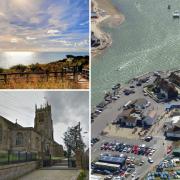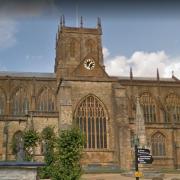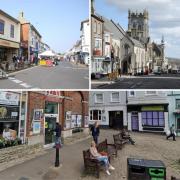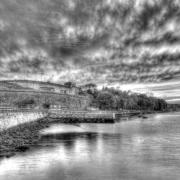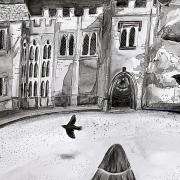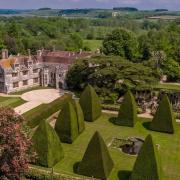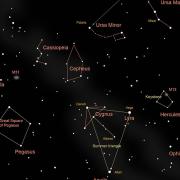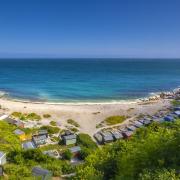A top secret Royal Naval facility briefly opened to the public during Dorset Architectural Heritage Week, Edward Griffiths is given a special tour by some former employees who reveal the vital role it played during two world wars
Even as Thomas Hardy was working on his Wessex Tales and the vanishing life of shepherds, farmers and dairy maids, several thousand Dorset men and women were already involved in better paid but decidedly more dangerous modern work at the Royal Naval Cordite Factory (RNCF) at Holton Heath.
They were making nitroglycerin, nitric acid and other hazardous materials for producing cordite, the latest shell propellant for the Navy’s biggest guns. To find out more I met up with John England a Research Chemist at RNCF and its successor Admiralty Materials Laboratory (AML) between 1952 and 1967, and Dr Bob Dukes, Principal Scientific Officer for 29 years at AML, who showed me around the site.
What is Cordite?
Cordite is a propellant and not an explosive. Smokeless powders, including cordite and Alfred Nobel’s version called Ballistite, were developed from the production of nitrated organic materials such as nitroglycerin and nitrocellulose, also known as gun-cotton, in the mid-19th century. The finished mixture is extruded like dough through dies to produce lengths of rope-like material, hence the name ‘Cordite’. These were made into bundles according to the amount of propellant needed.
With the outbreak of the First World War more shell propellant was needed and Winston Churchill, then First Lord of the Admiralty, decided that the Royal Navy needed its own propellant factory. The 500 acre site at Holton Heath was chosen because it was ideally positioned on the edge of Poole Harbour, with good rail and road links.
Building started in 1915 and the factory, consisting of two nitroglycerin plants AB and ABC, was up and running in just nine months. The first batch from Plant ABC plant was produced on 12 October 1916, and the last on 18 September 1945. Plant AB’s last batch was on 23 June 1931 but, significantly, in 1936, this plant was replaced by a continuous production unit installed by German engineers.
Cordite manufacture at that time needed lots of acetone, an organic solvent, to help incorporation of nitroglycerin with guncotton and the other minor additives. But due to a world shortage of acetone an alternative method of production was needed. A research biochemist, Dr Chaim Weizmann of Manchester University, created a new process of producing butyl alcohol and acetone using maize. His unique biochemical plant, installed in 1917, used vast quantities of American maize. When this became scarce hordes of Dorset schoolchildren collected conkers and acorns which were used instead so production could continue. The conkers, acorns and maize would eventually have ended up in the circular Acetone Distillation Tanks which John England calls “the biggest flower pots in the world.” You can still see the concrete tanks on the site alongside the Acetone Cooker House.
A local employer
The RNCF was effectively self-sufficient with its own gas works and gas-holders, electricity and steam generation plant, a water-supply from Corfe Mullen pumping station eight miles away, and an internal rail system together with its own rolling stock. During the First World War and until about 1938, cordite was moved to a jetty in Poole Harbour by rail where it was loaded onto sailing barges for transport to Priddy’s Hard in Gosport.
The nucleus of the operating staff was provided by the Royal Gunpowder Works at Waltham Abbey and Dorset personnel were sent there for training. During the First World War, about 2,500 people worked at RNCF, rising to a peak of 4,500 people working four shifts in the Second World War. Most came from Poole, Wareham, Upton and Wimborne.
The RNCF also had its own well-equipped hospital on site where minor day-to-day injuries were treated. It was at this hospital that microbiologist Dr Thaysen invented the first water-bed. This specialist bed has subsequently found applications across the world in relieving pressure on sensitive areas for burns victims.
Top Secret
Being a Naval establishment the factory’s Superintendent was always a Naval Captain and the RNCF personnel were bound by the Official Secrets Act; even their families didn’t know what they were doing, or the dangers involved. At the works entrance security guards ensured that all cigarette lighters and matches were left in pigeon-holes. Smoking was only allowed in designated safety-zoned Mess Rooms where gas jets were used to light them.
A 12 foot high steel fence surrounded the site and warning systems were in place in case of Zeppelin airships being sighted or heard. Being built on cleared heathland, the site was easily visible from land, sea and air, so 27,000 young trees were planted for camouflage and blast protection, but only time would increase their effectiveness.
By the Second World War, with increased threats from the air, buildings were camouflaged, and the trees, now nearly 25 years old, provided a screen. The Home Guard patrolled the area to ensure no lights were showing at night.
As well as anti-aircraft gun emplacements and fire teams, many ingenious defensive measures were taken including establishing Strategic Night Decoy sites nearby and on the Arne Peninsula to thwart enemy bombers. At the decoy sites, waste cordite and fuel oil was set alight to produce flames and explosions so enemy bombers would think that these were caused by the bombing raid before them and they’d drop their bombs in the same place.
Luftwaffe photographs of August 1940 showed that the Germans were well aware of the work being carried out at Holton Heath, undoubtedly confirmed by the German engineers who had installed the nitroglycerin plant in 1936. Clearly, the Arne Night Decoy worked well as RNCF was only ever hit by ten bombs, mostly incendiary, whereas Arne received up to 150 bombs.
High on Sandford Heath, not far from the RNCF site, a pair of reinforced concrete towers, now Grade 1 listed, supported an anti-aircraft gun and a predictor used to provide accurate target information. By 1944 most guns had been removed.
A fascinating museum in Britannia House at the RNCF tells the whole story of this extraordinary factory from 1915 to its closure in 1957. The centrepiece is the 1942 scale model of the entire site. Measuring 21ft by 18ft (40ft to one inch scale), it shows the factory and surrounding area during the Second World War with camouflaged buildings, railways, roads, and pier. The 1942 scale model has been described as ‘a document of national significance’ as it captures the importance of this top secret site which played such a vital role during two world wars.
***
More Information
A DVD entitled Cordite! The Story of the RNCF can be purchase by post for £12.99 from greenacre.info/page7.html or call 07831 116995. The DVD is also available locally in Wareham, Swanage, Parkstone, Bere Regis and Wimborne. For more information email orders@greenacre.info.
--------------------------------------------------
Read on
Dorset Wildlife Trust rescue Isle of Portland from rampant invader
People across Dorset prepare to host their own own Great Wessex Dinner




